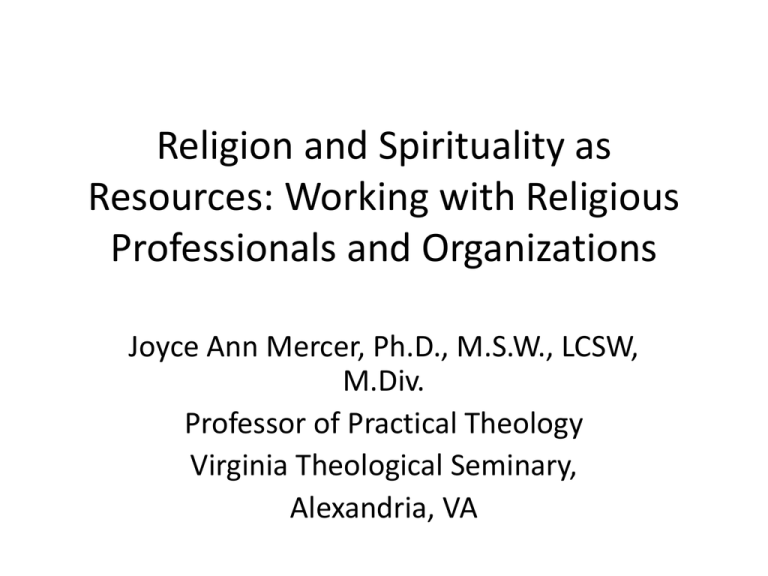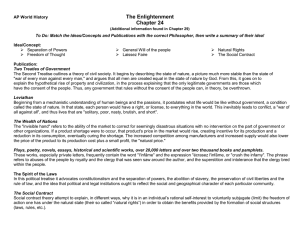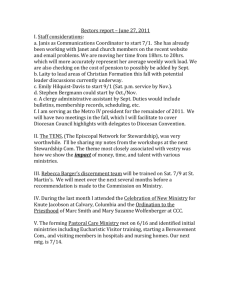Religion and Spirituality as Resources
advertisement

Religion and Spirituality as Resources: Working with Religious Professionals and Organizations Joyce Ann Mercer, Ph.D., M.S.W., LCSW, M.Div. Professor of Practical Theology Virginia Theological Seminary, Alexandria, VA Disclosures of Potential Conflicts Source Research Funding Employee Speakers’ Bureau Books, Intellectual Property In-kind Services (example: travel) Travel and expenses AACAP Louisville Institute Advisor/ Consultant 2 grants Congreg ational studies Stock or Equity > $10,000 Honorarium or expenses for this presentation or meeting honorari um Learning Objectives: 1. Attendees will become aware of the wide variety of education, professional backgrounds, work settings, job descriptions and services offered by clergy/religious professionals. 1. Attendees will develop appreciation of the varying degrees of respect and authority accorded to religious professionals and institutions by different major world faith traditions, ethnic groups, and cultural settings. Learning Objectives, continued 3. Attendees will become familiar with the wide range of social and support services for children and families offered through many community religious organizations. 4. Attendees will learn practical strategies for increasing collaboration between medical and mental heal clinicians and clergy and religious organizations on behalf of children and families. WHO AND WHAT ARE CLERGY AND RELIGIOUS PROFESSIONALS? Religion and Spirituality as Worldview: • Often connected to identity, race, ethnicity • Narrative • Belief system includes practices Clergy: persons ordained or otherwise set apart for religious leadership Education, training, and/or expertise within a particular faith tradition Endorsed for leadership by faith community Authority conferred by religious / ethnoreligious community Types of Religious Professionals • Community clergy in congregations, synagogues, mosques, local houses of worship • Chaplains in hospitals and other institutions • Pastoral counselors • Educators and teachers Common Terms & Titles: • • • • • • • • • Rabbi Priest Minister Imam Pastor Swami Guru Pastoral Counselor CPE Supervisor • • • • • • • • Reverend Pastor Father/Mother Sister/Brother Elder Chaplain Deacon Cantor Ritual/Liturgical Work in nonreligious settings Organizational Work of RELIGIOUS PROFESSIONALS Counseling and Education Ethnic/Cultura l Community Community Organizing/Advocacy Clergy in North America • 600,000 clergy of various Christian denominations in North America • 4000 rabbis • Unknown numbers of Muslim leaders • Multiple Others: LDS (Mormon), Native American shaman, Buddhist teachers, Sikh gurus Pastoral Counselors/Psychotherapists • Education and training • Accreditation, certification, supervision, continuing education • Relative strengths and weaknesses • Attitudes toward psychiatry and medicine • Pastoral counseling centers and practices Mental Health and Psychiatric Chaplaincy • Clinical Pastoral Education programs in psychiatry • Greater attention to clergy/patient boundaries • Discernment of unhealthy/pathological vs. healthy and adaptive religious/spiritual thought and practice RELIGIOUS/ SPIRITUAL AUTHORITY AND THE CLERGY OR RELIGIOUS PROFESSIONAL AUTHORITY • Important differences among religions, subgroups, regions • Ascribed vs. Achieved • Immigrant and refugee communities • Hierarchical and Congregational polities Preparation, Education, Certification of Religious Professionals: No single pathway • Major religions, subgroups within them have their own requirements • Also can differ by role, specialization, context of ministry Most Common Education and Credentials A) 4 year college degree + 3-5 year graduate professional degree M.Div. “Master of Divinity” B) Clinical Pastoral Education (CPE) C) Ordination requirements ? No particular requirements Extensive graduate education and certification Other common degree programs: • Doctor of Ministry (D.Min.) • University divinity schools • Master of Theology (Th. M/STM ) • Denominational seminaries • Master of Sacred Music • Cooperative consortia of theology schools • M. A. in ______ (e.g., Jewish Studies) Graduate Education for Ministry • 251 accredited schools in North America (2005 figure) • 1/3 of seminary students are women • 2x as many men graduate with M.Div. • About to see first schools for training imam • Jewish seminaries—3 major seminaries, many yeshiva schools Ordination • Endorsement by religious community after process (some= rigorous, others less so) • “Ordination exams” • Conferral of authority (sacramental, interpretive, etc.) by religious community • Some religious professionals are not ordained—different use of term “lay person” Specialized training/accreditation • Chaplains • Educators • Pastoral Counselors • Clinical Pastoral Education • AAPC • AACC • NACC • Muslim Chaplaincy Association • Dual Degrees • “Second Career” Clergy have extensive contact with distressed people and groups: • People report 5 x more likely to contact clergy than all mental health professionals combined when faced with death of someone close to them • Access to everyday lives of families, especially in transitions (birth, death, job loss, crisis, adolescence to adulthood) Help Seeking from Clergy heightened among: • Ethnic and racial minority groups • Rural population • Some adolescents How important is religion to people? Gallup Research: approx. 40% of US population attends a religious service each week; actual “attendees” probably closer to 20% 72% of general public respond affirmatively to “My whole approach to life is based on my religion.” Psychologists agree least (33%), followed by psychiatrists (39%) As resources in care, clergy have • Unique access, involvement in everyday lives of people • Bridge capacities— cultural, linguistic, worldview and meanings accorded to suffering and distress • Wide networks— access to multiple groups, concrete resources & services • SPECIALIZED KNOWLEDGE OF RELIGION(S) AND RELIGIOUS PRACTICES UNDERSTANDING RELIGIOUS ORGANIZATIONS AND FAITH COMMUNITIES Where do religious professionals and clergy work? • Most common = leaders of congregations, synagogues, mosques, “houses of worship” 335,000 Christian congregations in US 3,700 Jewish congregations 1,660 Muslim mosques 2228 Buddhist centers 69 Jain centers 274 Hindu temples/centers “Pastoral” Role: 5 Functions 1.Healing—promoting resiliency, coping, & return to wholeness 1.Guiding—helping persons and communities make difficult decisions 1.Sustaining—support, engaging resources of faith to deal with suffering 4. Reconciling—encouraging “right relationship” through practices of forgiveness • mediating conflict • promoting community 4. Advocating—assisting persons through addressing structural & systems issues • work to overcome inequities, meet needs • promote justice Hartford study on congregations in communities: Average congregation has partnerships with 6 community organizations • • • • • Money Volunteers In-kind donations Space Staff time WHAT CONGREGATIONS OFFER Advocacy Direct service Self-Help & Personal Growth Education health, culture Community Develop. Community Outreach Services • • • • • • • Senior citizen programs Prison or jail ministries Child day care Substance abuse programs Literacy and tutoring programs English as a Second Language (ESL) Immigrant and migrant support Community Outreach Services • Transportation assistance • Voter registration • Job training Medical Services • • • • • • Emergency cash assistance Budgeted contributions Low cost health clinics Transportation to and from appointments Child care during appointments Parish nursing Mental Health Services and Support • Pastoral counselors and counseling centers • Twelve Step programs • Support groups Culturally based ministries • • • • Ethnic houses of worship Language services Socialization Acculturation Miscellaneous • • • • • • Athletics Music, arts, drama Adoptive-grandparent programs Vision and hearing impaired Day camps and summer overnight camps Elder care and services Parachurch Organizations • • • • • • • Youth for Christ Campus Crusade for Christ Focus on the Family Billy Graham Evangelistic Association World Vision American Bible Society Gideons International Congregations offer resources of • Religious and spiritual “capital” • Cost effective extensions of care through concrete services and supports • “Social capital” STRATEGIES FOR COLLABORATION Past barriers to collaboration • History of mutual suspicion: different epistemologies, sometimes different value systems • Stereotyping/ lack of respect for differences • Not valuing the resources of religious traditions for healing Primary issue: Absence of good collegial working relationships between mental health professionals and religious professionals Current Issues • HIPAA and privacy concerns • Immigration issues • Potential clash of worldviews • Declining public trust Reasons to Collaborate • Religion and spirituality influence the everyday lives and emotional/psychological well-being of a large number of people in the U.S. • Ethical obligation to provide care in best interests of clients • Clergy as gatekeepers Religion helps alleviate stress, promotes coping: 1. Promotes positive worldview 2. Helps make sense of difficult situations 3. Gives purpose and meaning 4. Discourages maladaptive coping 5. Enhances social support 6. Promotes other-directedness 7. Helps release the need for control 8. Provides and encourages forgiveness 9. Encourages thankfulness 10. Provides hope. FIVE STRATEGIES FOR COLLABORATION ①CONSULTATION -with chaplains—bridge people between health care and community (Get connected!) -with community religious leaders in general (Get information!) -with a patient’s particular clergy or religious professional (Get consent!) ② NETWORKING Ministerial alliances and Interfaith/ Ecumenical organizations Develop referral networks (clergy, congregational resources) specific to your patient population. Ask for information about a faith group’s practices, beliefs, and resources. ③INVOLVEMENT In spiritual assessment and discharge planning To provide religious resources in therapeutic process Ritual and sacramental Support- and direct services On committees and work groups trauma response teams ethics committees adolescent suicide prevention task forces ④EDUCATION Clergy and religious professionals: + to recognize/respond to serious mental health issues in their roles as ‘first point of contact” + to support goals and process of treatment Mental health professionals : + to learn about religion and spirituality + to respect and engage persons’ belief systems in the work of healing ⑤Cultivating Mutual Respect +acknowledgement and ‘non-violent communication’ +curiosity and openness to different worldviews +appreciation of particular abilities, education, and/or authority in community Context for Current Focus: Common Ground for Religion and Mental Health • Mutual concern to ameliorate suffering and distress • Interested in promoting health, well-being, thriving of persons and groups • Recognition of persons as bio-psycho-socialspiritual calls for collaborative engagement. Gifts of Religion and Spirituality at their Best • • • • • • Meaning Balance Vocation/Purpose Community Wholeness Reconciliation Self-Test Questions 1. The usual title for religious professionals who are employees of a hospital, prison, or other institutional setting is: A. Masjid B. Chaplain C. Counselor D. Professor 2. The most common graduate degree for clergy education, involving 3-5 years of study beyond the undergraduate degree, is the A. B. C. D. M.Div. –Master of Divinity M.Min.—Master of Ministry Ph.D.—Doctor of Philosophy M.S.W.—Master of Social Work 3. Community clergy and religious professionals: A. Undergo a uniform, common credentialing process across faith traditions. B. Are required to undergo Clinical Pastoral Education in psychiatric facilities before ordination therefore they all know how to recognize mental illnesses. C. Are respected leaders and spokespersons for their communities who help facilitate access to mental health systems. D. oppose the use of psychiatric medications in favor of spiritual cures. 4. In what ways are religious congregations a resource for the health of children and families? A. They provide financial help if the family already belongs to the congregation. B. They can strengthen religious/spiritual supports for coping with difficulty, along with providing services such as transportation or emergency financial assistance. C. They promote insularity among ethno-religious groups to keep families separated. D. They offer promises of a better future and send children away. 5. One strategy for better collaboration between child and adolescent psychiatrists and clergy is: A. Forming a network of clergy and religious professionals with whom to consult. B. Asking families to give up most of their religious practices. C. Avoid talking about differences. D. None. JCAHO prohibits collaboration with clergy. Selected References Dell, M. L. (2004). Religious Professionals and Institutions: Untapped Resources for Clinical Care. Child and Adolescent Psychiatry Clinics of North America, 13(1), 85-110. Koenig, H. G. (2005). Faith and mental health : religious resources for healing. Philadelphia: Templeton Foundation Press. Vandecreek, L., Carl, D., & Parker, D. (1998). The Role of Nonparish Clergy in the Mental Health System. In H. G. Koenig (Ed.), Handbook of Religion and Mental Health (pp. 337-348). San Diego: Academic Press. Weaver, A. J., Flannelly, K. J., Flannelly, L. T., & Oppenheimer, J. E. (2003). Collaboration Between Clergy and Mental Health Professionals: A Review of Professional Health Care Journals From 1980-1990. Counseling and Values, 47(April 2003), 162171. Helpful Websites: • Hartford Institute for Religion Research http://hirr.hartsem.edu/ • Faith Communities Today http://faithcommunitiestoday.org/ • The Pluralism Project (Harvard) http://pluralism.org/





